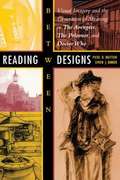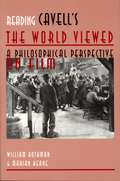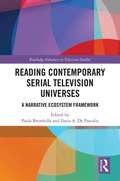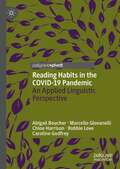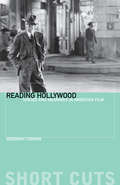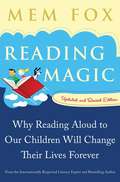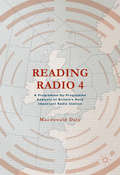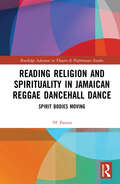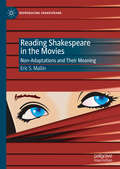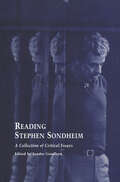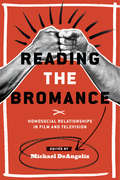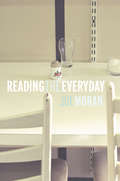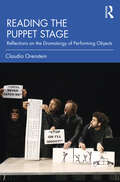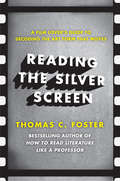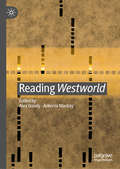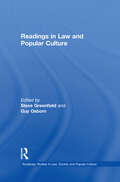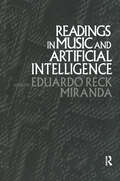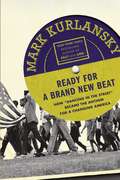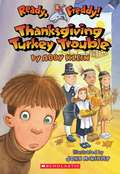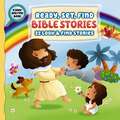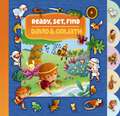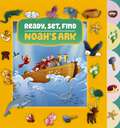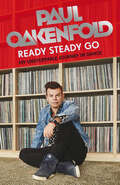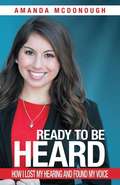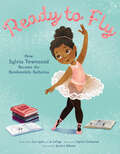- Table View
- List View
Reading between Designs: Visual Imagery and the Generation of Meaning in The Avengers, The Prisoner, and Doctor Who
by Piers D. Britton Simon J. BarkerFrom the alien worlds of Star Trek to the realistic operating room of ER, the design of sets and costumes contributes not only to the look and mood of television shows, but even more importantly to the creation of memorable characters. Yet, until now, this crucial aspect of television creativity has received little critical attention, despite the ongoing interest in production design within the closely allied discipline of film studies.<P><P>In this book, Piers Britton and Simon Barker offer a first analytical study of scenic and costume design for television drama series. They focus on three enduringly popular series of the 1960s--The Avengers, The Prisoner, and Doctor Who--and discuss such topics as the sartorial image of Steed in The Avengers, the juxtaposition of picturesque and fascistic architecture in The Prisoner, and the evolution of the high-tech interior of Doctor Who's TARDIS. Interviews with the series' original designers and reproductions of their original drawings complement the authors' analysis, which sheds new light on a variety of issues, from the discourse of fashion to that of the heritage industry, notions of "Pop" and retro, and the cultural preoccupation with realism and virtual reality.
Reading Cavell's The World Viewed: A Philosophical Perspective on Film
by Marian Keane William RothmanIn their thoughtful study of one of Stanley Cavell's greatest yet most neglected books, William Rothman and Marian Keane address this eminent philosopher's many readers, from a variety of disciplines, who have neither understood why he has given film so much attention, nor grasped the place of The World Viewed within the totality of his writings about film. Rothman and Keane also reintroduce The World Viewed to the field of film studies. When the new field entered universities in the late 1960s, it predicated its legitimacy on the conviction that the medium's artistic achievements called for serious criticism and on the corollary conviction that no existing field was capable of the criticism filmed called for. The study of film needed to found itself, intellectually, upon a philosophical investigation of the conditions of the medium and art of film. Such was the challenge The World Viewed took upon itself. However, film studies opted to embrace theory as a higher authority than our experiences of movies, divorcing itself from the philosophical perspective of self-reflection apart from which, The World Viewed teaches, we cannot know what movies mean, or what they are. Rotham and Keane now argue that the poststructuralist theories that dominated film studies for a quarter of a century no longer compel conviction, Cavell's brilliant and beautiful book can provide a sense of liberation to a field that has forsaken its original calling. read in a way that acknowledges its philosophical achievement, The World Viewed can show the field a way to move forward by rediscovering its passion for the art of film. Reading Cavell's The World Viewed will prove invaluable to scholars and students of film and philosophy, and to those in other fields, such as literary studies and American studies, who have found Cavell's work provocative and fruitful.
Reading Contemporary Serial Television Universes: A Narrative Ecosystem Framework (Routledge Advances in Television Studies)
by Paola Brembilla Ilaria A. De PascalisReading Contemporary Serial Television Universes provides a new framework—the metaphor of the narrative ecosystem—for the analysis of serial television narratives. Contributors use this metaphor to address the ever-expanding and evolving structure of narratives far beyond their usual spatial and temporal borders, in general and in reference to specific series. Other scholarly approaches consider each narrative as composed of modular elements, which combine to create a bigger picture. The narrative ecosystem approach, on the other hand, argues that each portion of the narrative world contains all of the main elements that characterize the world as a whole, such as narrative tensions, production structures, creative dynamics and functions. The volume details the implications of the narrative ecosystem for narrative theory and the study of seriality, audiences and fandoms, production, and the analysis of the products themselves.
Reading Habits in the COVID-19 Pandemic: An Applied Linguistic Perspective
by Abigail Boucher Marcello Giovanelli Chloe Harrison Robbie Love Caroline GodfreyThis book presents and analyses the results of the Lockdown Library Project survey, using a range of quantitative and qualitative approaches to provide a unique insight into the ways in which the first UK COVID-19 lockdown affected public reading habits. The authors begin by outlining the background to the study, the research methodology and design, and an overview of the headlines of the data, before going on to survey the literature on the relationship between pandemics, literature (especially the role played by genre and popular fiction) and reading habits. They then examine how participants reported that the lockdown period had affected the amount that they read; how they accessed books and discussed their reading with others; the use of reading as a coping strategy; and returning to re-read books that offered familiarity, reliability, and nostalgia. Finally, the concluding chapter brings together the overall findings of the project and briefly outlines future work in the field. This book will be of interest to academics in fields such as literary and genre studies, applied linguistics, corpus linguistics, stylistics, health humanities, and sociology, as well as practitioners working in education, in bibliotherapy, and in libraries.
Reading Hollywood: Spaces and Meanings in American Film (Short Cuts)
by Deborah ThomasThis book examines the treatment of space and narrative in a selection of classic films including My Darling Clementine, It's a Wonderful Life, and Vertigo. Deborah Thomas employs a variety of arguments in exploring the reading of space and its meaning in Hollywood cinema and film generally. Topics covered include the importance of space in defining genre (such as the necessity of an urban landscape for a gangster film to be a gangster film); the ambiguity of offscreen space and spectatorship (how an audience reads an unseen but inferred setting), and the use of spatially disruptive cinematic techniques such as flashback to construct meaning.
Reading Magic: Why Reading Aloud to Our Children Will Change Their Lives Forever
by Mem FoxWith passion and humor, Fox speaks of when, where, and why to read aloud and demonstrates how to read aloud to best effect and get the most out of a read-aloud session. She discusses the three secrets of reading, offers guidance on defining and choosing good books.
Reading Radio 4
by Macdonald DalyThis book is a study of contemporary Radio 4 output, covering the entire broadcast day. Radio is largely neglected by media and cultural studies. The small body of existing work on Radio 4 is predominantly historical, focusing on institutional history, or sociological, focusing on contemporary BBC editorial and journalistic practices. Reading Radio 4, by contrast, analyses contemporary Radio 4 programmes entirely from the point of view of today's listener. Individual chapters correspond to all existing Radio 4 timeslots in the entire broadcast day of 19 hours 40 minutes, from 5. 20am to 1. 00am. The study, while academic in approach, aims to promote an informed and critical appreciation of Radio 4 for all listeners, as well as students of the media.
Reading Religion and Spirituality in Jamaican Reggae Dancehall Dance: Spirit Bodies Moving (Routledge Advances in Theatre & Performance Studies)
by 'H' PattenThis book explores the genealogy of Jamaican dancehall while questioning whether dancehall has a spiritual underscoring, foregrounding dance, and cultural expression. This study identifies the performance and performative (behavioural actions) that may be considered as representing spiritual ritual practices within the reggae/dancehall dance phenomenon. It does so by juxtaposing reggae/dancehall against Jamaican African/neo-African spiritual practices such as Jonkonnu masquerade, Revivalism and Kumina, alongside Christianity and post-modern holistic spiritual approaches. This book will be of great interest to students and scholars in performance studies, popular culture, music, theology, cultural studies, Jamaican/Caribbean culture, and dance specialists.
Reading Shakespeare in the Movies: Non-Adaptations and Their Meaning (Reproducing Shakespeare)
by Eric S. MallinReading Shakespeare in the Movies: Non-Adaptations and Their Meaning analyzes the unacknowledged, covert presence of Shakespearean themes, structures, characters, and symbolism in selected films. Writers and directors who forge an unconscious, unintentional connection to Shakespeare’s work create non-adaptations, cinema that is unexpectedly similar to certain Shakespeare plays while remaining independent as art. These films can illuminate core semantic issues in those plays in ways that direct adaptations cannot. Eric S. Mallin explores how Shakespeare illuminates these movies, analyzing the ways that The Godfather, Memento, Titanic, Birdman, and The Texas Chainsaw Massacre take on new life in dialogue with the famous playwright. In addition to challenging our ideas about adaptation, Mallin works to inspire new awareness of the meanings of Shakespearean stories in the contemporary world.
Reading Stephen Sondheim: A Collection of Critical Essays (Studies in Modern Drama #Vol. 10)
by Sandor GoodhartFirst Published in 2000. Routledge is an imprint of Taylor & Francis, an informa company.
Reading the Bromance: Homosocial Relationships in Film and Television
by Michael DeangelisIn the middle of this century's first decade, "bromance" emerged as a term denoting an emotionally intense bond between straight men. Yet bromance requires an expression of intimacy that always toys with being coded as something other than "straight" male behavior, even as it insists that such intimacy must never be misinterpreted. In Reading the Bromance: Homosocial Relationships in Film and Television, editor Michael DeAngelis has compiled a diverse group of essays that address the rise of this tricky phenomenon and explore the social and cultural functions it serves. Contributors consider selected contemporary film and television texts, as well as the genres that historically inspired them, in order to explore what needs bromance attempts to fulfill in relationships between men--straight or otherwise. Essays analyze films ranging from I Love You, Man to Superbad, Humpday, I Now Pronounce You Chuck and Larry, The Hangover, and the Jackass films, and include studies of representative examples in international cinema such as Y tu mama tambien and classic and contemporary films of the Bollywood genre. The volume also examines the increasingly prevalent appearance of the bromance phenomenon in television narratives, from the "male bonding" rituals of Friends and Seinfeld to more recent manifestations in House, The Wire, and the MTV reality series Bromance. From historical analysis to discourse analysis, sociological analysis, and queer theory, this volume provides a broad range of methodological and theoretical approaches to the phenomenon in the first booklength study of the bromance genre. Film and television scholars as well as readers interested in pop culture and queer studies will enjoy the insights of Reading the Bromance.
Reading the Everyday
by Joe MoranIn an ever-growing field of study, this is a major contribution to one of the key areas in cultural studies and cultural theory – the spaces, practices and mythologies of our everyday culture. Drawing on the work of such continental theorists as Henri Lefebvre, Michel de Certeau, Marc Augé and Siegfried Kracauer, Joe Moran explores the concrete sites and routines of everyday life and how they are represented through political discourse, news media, material culture, photography, reality TV shows, CCTV and much more. Unique in his focus of the under-explored, banal aspects of everyday culture, including office life, commuting, traffic and mass housing, Moran re-evaluates conventional notions of everyday life in cultural studies, and shows that analysing such ‘boring’ phenomena can help make sense of cultural and social change. This book is interdisciplinary in its approach and covers many different areas including visual culture, cultural geography, material culture, and cultural history as well as the key areas of cultural studies and sociology. Students from all these subjects will find this clearly written and lively work an invaluable study resource.
Reading the Puppet Stage: Reflections on the Dramaturgy of Performing Objects
by Claudia OrensteinDrawing on the author’s two decades of seeing, writing on, and teaching about puppetry from a critical perspective, this book offers a collection of insights into how we watch, understand, and appreciate puppetry. Reading the Puppet Stage uses examples from a broad range of puppetry genres, from Broadway shows and the Muppets to the rich field of international contemporary performing object experimentation to the wealth of Asian puppet traditions, as it illustrates the ways performing objects can create and structure meaning and the dramaturgical interplay between puppets, performers, and language onstage. An introductory approach for students, critics, and artists, this book underlines where significant artistic concerns lie in puppetry and outlines the supportive networks and resources that shape the community of those who make, watch, and love this ever-developing art.
Reading the Silver Screen: A Film Lover's Guide to Decoding the Art Form That Moves
by Thomas C. FosterFrom the New York Times bestselling author of How to Read Literature Like a Professor comes an indispensable analysis of our most celebrated medium, film.No art form is as instantly and continuously gratifying as film. When the house lights go down and the lion roars, we settle in to be shocked, frightened, elated, moved, and thrilled. We expect magic. While we're being exhilarated and terrified, our minds are also processing data of all sorts--visual, linguistic, auditory, spatial--to collaborate in the construction of meaning.Thomas C. Foster's Reading the Silver Screen will show movie buffs, students of film, and even aspiring screenwriters and directors how to transition from merely being viewers to becoming accomplished readers of this great medium. Beginning with the grammar of film, Foster demonstrates how every art form has a grammar, a set of practices and if-then propositions that amount to rules. He goes on to explain how the language of film enables movies to communicate the purpose behind their stories and the messages they are striving to convey to audiences by following and occasionally breaking these rules.Using the investigative approach readers love in How to Read Literature Like a Professor, Foster examines this grammar of film through various classic and current movies both foreign and domestic, with special recourse to the "AFI 100 Years-100 Movies" lists. The categories are idiosyncratic yet revealing. In Reading the Silver Screen, readers will gain the expertise and confidence to glean all they can from the movies they love.
Reading Westworld
by Alex Goody Antonia MackayReading Westworld is the first volume to explore the cultural, textual and theoretical significance of the hugely successful HBO TV series Westworld. The essays engage in a series of original enquiries into the central themes of the series including conceptions of the human and posthuman, American history, gaming, memory, surveillance, AI, feminism, imperialism, free will and contemporary capitalism. In its varied critical engagements with the genre, narratives and contexts of Westworld, this volume explores the show’s wider and deeper meanings and the questions it poses, as well considering how Westworld reflects on the ethical implications of artificial life and technological innovation for our own futurity. With critical essays that draw on the interdisciplinary strengths and productive intersections of media, cultural and literary studies, Reading Westworld seeks to respond to the show’s fundamental question; “Have you ever questioned the nature of your reality?” It will be of interest to students, academics and general readers seeking to engage with Westworld and the far-reaching questions it poses about our current engagements with technology.
Readings in Law and Popular Culture (Routledge Studies in Law, Society and Popular Culture)
by Guy Osborn Steven GreenfieldReadings in Law and Popular Culture is the first book to bring together high quality research, with an emphasis on context, from key researchers working at the cutting-edge of both law and cultural disciplines. Fascinating and varied, the volume crosses many boundaries, dealing with areas as diverse as football-based computer games, Buffy the Vampire Slayer, digital sampling in the music industry, the films of Sidney Lumet, football hooliganism, and Enid Blyton. These topics are linked together through the key thread of the role of, or the absence of, law - therefore providing a snapshot of significant work in the burgeoning field of law and popular culture. Including important theoretical and truly innovative, relevant material, this contemporary text will enliven and inform a legal audience, and will also appeal to a much broader readership of people interested in this highly topical area.
Readings in Music and Artificial Intelligence (Contemporary Music Studies #20)
by Eduardo Reck MirandaFirst published in 2000. Routledge is an imprint of Taylor & Francis, an informa company.
Ready for a Brand New Beat: How "Dancing in the Street" Became the Anthem for a Changing America
by Mark KurlanskyCan a song change a nation? In 1964, Marvin Gaye, record producer William "Mickey" Stevenson, and Motown songwriter Ivy Jo Hunter wrote "Dancing in the Street. " The song was recorded at Motown's Hitsville USA Studio by Martha and the Vandellas, with lead singer Martha Reeves arranging her own vocals. Released on July 31, the song was supposed to be an upbeat dance recording--a precursor to disco, and a song about the joyousness of dance. But events overtook it, and the song became one of the icons of American pop culture. The Beatles had landed in the U. S. in early 1964. By the summer, the sixties were in full swing. The summer of 1964 was the Mississippi Freedom Summer, the Berkeley Free Speech Movement, the beginning of the Vietnam War, the passage of the Civil Rights Act, and the lead-up to a dramatic election. As the country grew more radicalized in those few months, "Dancing in the Street" gained currency as an activist anthem. The song took on new meanings, multiple meanings, for many different groups that were all changing as the country changed. Told by the writer who is legendary for finding the big story in unlikely places,Ready for a Brand New Beatchronicles that extraordinary summer of 1964 and showcases the momentous role that a simple song about dancing played in history.
Ready, Freddy! Thanksgiving Turkey Trouble (Ready, Freddy! #(#15))
by Abby KleinWould you believe being a turkey for the first grade Thanksgiving play will get Freddy locked up in jail? Freddy believes it. In fact he believes all kinds of terrible things will happen if he has to dress up as a turkey for the play. <P><P> At school there's teasing, bullying, copy-catting, tattling, joking, arguments, laughing, time-outs and all kinds of kid and teacher stuff you've had in your own school. At home, there's teasing from Freddy's sister and understanding from his mom, but they don't help him get over having to be the turkey. <P><P>Finally, just in time, Freddy learns a trick that will make being a turkey fun! At the end of the story are some ideas for Thanksgiving crafts.
Ready, Set, Find Bible Stories: 22 Look and Find Stories (Ready, Set, Find)
by ZondervanGet ready to read through 22 of the most famous Bible stories in the Ready, Set, Find Storybook Bible, the next book in the beloved Ready, Set, Find brand. Children will be immersed and engaged in each story as they look for more than 190 different objects to be found in this exciting book. Featuring classic stories including the Creation Story, Noah and the Ark, the birth of Jesus, and more, this lively and colorfully illustrated Bible is sure to be a favorite for young readers to ready, set, find!
Ready, Set, Find David and Goliath (Ready, Set, Find)
by ZondervanDavid is only a young boy, but he is about to fight a giant! Even though Goliath the giant is big, strong, and scary, David isn&’t afraid. He knows God is on his side. And guess what? You can help David too! See if you can spot the 48 hidden items in this book—like a slingshot and stones—so David can defeat Goliath.Ready, Set, Find as you read the story of David and Goliath in this interactive book for young readers.
Ready, Set, Find Noah's Ark (Ready, Set, Find)
by ZondervanA faithful retelling and exploration of the story of Noah and the Ark for young children, Ready, Set Find Noah&’s Ark follows Noah as he does an important job for God. Noah has an important job. He needs to build a huge ark and fill it with animals too. Now there are things and animals along the way he needs your help to find, like the hammer, the hen, and the hedgehog. Are you ready to help Noah? If so, on your mark, Ready, Set, Find! Read the classic story of Noah&’s Ark in this engaging look-and-find book for young children.Ready, Set Find Noah&’s Ark:Perfect for families to share in the storytelling processIncludes Scripture references for further readingChildren will love the interactive component of finding the hidden objects
Ready Steady Go: My Unstoppable Journey in Dance
by Paul Oakenfold"A wild ride of a life... Oakenfold's story is extraordinary" - The Times Follow Paul Oakenfold – world-renowned DJ and dance music pioneer – as he tells his incredible story of a phenomenal career at the beating heart of dance.Paul's journey takes him from a musical baptism in 1980s New York and underground club nights in London to running a seminal dance record label and a legendary trip to Ibiza that introduced him to trance and changed the face of dance music forever.A breathless adventure through music, Ready Steady Go is a story of dance, trance, excess and success.
Ready To Be Heard: How I Lost My Hearing And Found My Voice
by Amanda McDonoughWhen author Amanda McDonough started losing her hearing at the age of 4 she swore her parents to secrecy. She hid her hearing loss for 18 years from her friends, family, teachers, and acquaintances. As the author grew older, her hearing gradually decreased, causing her to begin struggling in school, in her relationships with family and friends, and with her identity. By age twenty-two, she could no longer rely on her wit to hide her hearing loss. She became one hundred percent deaf in both ears. Amanda found herself unable to hear, talk, lip-read or sign. Her only method of communication with the world was through writing. Ready to be Heard is the story of how Amanda taught herself to speak again, to lip-read, and to sign. McDonough explains how she discovered a new culture, language, and most importantly, herself. In this memoir, the author narrates how she managed to finish college after becoming deaf. How she garnered straight As in school, entered the workforce, enjoyed a successful Hollywood acting career (Freeforms Switched at Birth, ABCs Speechless, NBCs Bad Judge, Google, 7UP, Deaf West/ Pasadena Playhouses Our Town, etc.), fought for her independence, and found her purpose. Ready to be Heard tells about the authors journey to find a balance between the hearing world she was raised in and the Deaf culture to which she now belonged.
Ready to Fly: How Sylvia Townsend Became the Bookmobile Ballerina
by Lea Lyon Alexandria LaFayeLyrical, inspiring, and affecting text paired with bright, appealing illustrations make Ready to Fly perfect for aspiring ballerinas everywhere who are ready to leap and to spread their wings!Ready to Fly is the true story of Sylvia Townsend, an African American girl who falls in love with ballet after seeing Swan Lake on TV. This nonfiction picture book is an excellent choice to share at home or in the classroom. Although there aren’t many ballet schools that will accept a girl like Sylvia in the 1950s, her local bookmobile provides another possibility. A librarian helps Sylvia find a book about ballet and the determined seven-year-old, with the help of her new books, starts teaching herself the basics of classical ballet.Soon Sylvia learns how to fly—how to dance—and how to dare to dream.Includes a foreword from Sylvia Townsend, a brief history of the bookmobile, an author’s note, and a further reading list.
